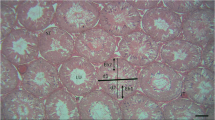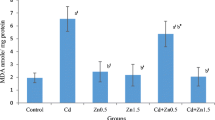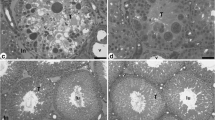Abstract
This study aimed to compare Cd exposure by intraperitoneal (i.p.) and oral routes, evaluating the testicular subacute and subchronic effects. Adult male mice were separated into three groups subdivided according to the experimental period (7 and 42 days after Cd exposure: subacute and subchronic effects, respectively): one group received water and two groups received CdCl2 (1.2 mg/kg i.p. and 24 mg/kg oral). The testicular concentration of essential minerals and Cd, activity of antioxidant enzymes and markers of oxidative stress, histology, and testicular histomorphometry were evaluated. The subacute effect of oral Cd showed reduced Fe concentration, while Ca and Cu increased in this route. The subchronic effect promoted decreasing in Mg in i.p. and oral routes, whereas Zn decreased only in the oral, and the Fe concentration did not change. SOD activity decreased in the oral subacute evaluation and in both pathways, i.p. and oral routes, in the subchronic evaluation, while GST activity increased, and MDA concentration decreased. Labeling of apoptotic cells was increased in the subacute and subchronic evaluation. Seminiferous epithelium degeneration, death of germ cells, and Leydig cell damages occurred in i.p. and oral routes. However, these damages were more intense in the oral route, mainly evaluating the subchronic effects. The results confirm that the severity of Cd-induced testicular injury depends on the pathway, as well as the duration of exposure.








Similar content being viewed by others
References
WHO World Health Organization (2010) Exposure to cadmium: a major public health concern. http://www.who.int/ipcs/features/cadmium.pdf?ua=1. Accessed 2019
Singh VP (2005) Metal toxicity and tolerance in plants and animals. Sarup & Sons, New Delhi, p 328
Yang H, Shu Y (2015) Cadmium transporters in the kidney and cd-induced nephrotoxicity. Int J Mol Sci 16(1):1484–1494
Jha UC, Bohra A (2016) Genomics enabled breeding approaches for improving cadmium stress tolerance in plants. Euphytica 208(1):1–31
Shi Z, Taylor AW, Riley M, Byles J, Liu J, Noakes M (2018) Association between dietary patterns, cadmium intake and chronic kidney disease among adults. Clin Nutr 37(1):276–284
Predes FS, Diamante MAS, Dolder H (2010) Testis response to low doses of cadmium in Wistar rats. Int J Exp Pathol 91(2):125–131
Cupertino MC, Novaes RD, Santos EC et al (2017a) Cadmium-induced testicular damage is associated with mineral imbalance, increased antioxidant enzymes activity and protein oxidation in rats. Life Sci 15:23–30
Cupertino MC, Novaes RD, Santos EC, Neves AC, Silva E, Oliveira JA, Matta SLP (2017b) Differential susceptibility of germ and Leydig cells to cadmium-mediated toxicity: impact on testis structure, adiponectin levels and steroidogenesis. Oxidative Med Cell Longev 2017:3405089. https://doi.org/10.1155/2017/3405089
Wu X, Guo X, Wang H, Zhou S, Li L, Chen X, Wang G, Liu J, Ge HS, Ge RS (2017) A brief exposure to cadmium impairs Leydig cell regeneration in the adult rat testis. Sci Rep 7(1):6337
Turner TT, Lysiak JJ (2008) Oxidative stress: a common factor in testicular dysfunction. J Androl 29(5):488–498
Arafa MH, Mohammad NS, Atteia HH (2014) Fenugreek seed powder mitigates cadmium-induced testicular damage and hepatotoxicity in male rats. Exp Toxicol Pathol 66:293–300
Al-Azemi M, Omu FE, Kehinde EO, Anim JT, Oriowo MA, Omu AE (2010) Lithium protects against toxic effects of cadmium in the rat testes. J Assist Reprod Genet 27(8):469–476
Blanco A, Moyano R, Lopez AMM, Blanco C, Flores-Acuna R, Garcıa-Flores JR, Espada M, Monterde JG (2010) Preneoplastic and neoplastic changes in the Leydig cells population in mice exposed to low doses of cadmium. Toxicol Ind Health 26(8):451–457
Waalkes MP, Anver M, Diwan BA (1999) Carcinogenic effects of cadmium in the noble (NBL/Cr) rat: induction of pituitary, testicular, and injection site tumors and intraepithelial proliferative lesions of the dorsolateral prostate. Toxicol Sci 52(2):154–161
Matovic V, Buha A, Bulat Z, Ðukić-Ćosić D, Miljković M, Ivanišević J, Kotur-Stevuljević (2012) Route-dependent effects of cadmium/cadmium and magnesium acute treatment on parameters of oxidative stress in rat liver. Food Chem Toxicol 50:552–557
El-Demerdash FM (2004) Antioxidant effect of vitamin E and selenium on lipid peroxidation, enzyme activities and biochemical parameters in rats exposed to aluminium. J Trace Elem Med Biol 18(1):113–121
Amara S, Abdelmelek H, Garrel C (2008) Preventive effect of zinc against cadmium-induced oxidative stress in the rat testis. J Reprod Dev 54(2):129–134
Bu T, Yuling MI, Zeng W, Zhang C (2001) Protective effect of quercetin on cadmium-induced oxidative toxicity on germ cells in male mice. Anat Rec 294(3):520–526
Adamkovicova M, Toman R, Cabaj M (2014) Effects of subchronic exposure to cadmium and diazinon on testis and epididymis in rats. Sci World J 2014:632581. https://doi.org/10.1155/2014/632581
Farag MR, El-Aziz RMA, Ali HA, Ahmed SA (2016) Evaluating the ameliorative efficacy of Spirulina platensis on spermatogenesis and steroidogenesis in cadmium-intoxicated rats. Environ Sci Pollut Res 23(3):2454–2466
Leite RP, Wada RS, Monteiro JC, Predes FS, Dolder H (2011) Protective effect of guaraná (Paullinia cupana var. sorbilis) pre-treatment on cadmium-induced damages in adult Wistar testis. Biol Trace Elem Res 141(1–3):262–274
Lamas CA, Gollücke APB, Dolder H (2015) Grape juice concentrate (G8000®) intake mitigates testicular morphological and ultrastructural damage following cadmium intoxication. Int J Exp Pathol 96(5):301–310
Li R, Luo X, Li L (2016) The protective effects of melatonin against oxidative stress and inflammation induced by acute cadmium exposure in mice testis. Biol Trace Elem Res 170(1):152–164
Sonmez MF, Tascioglu S (2016) Protective effects of grape seed extract on cadmium-induced testicular damage, apoptosis, and endothelial nitric oxide synthases expression in rats. Toxicol Ind Health 32(8):1486–1494
Adaramoye OA, Akanni OO (2016) Protective effects of Artocarpus altilis (Moraceae) on cadmium-induced changes in sperm characteristics and testicular oxidative damage in rats. Andrology 48(2):152–163
Predes FS, Diamante MAS, Foglio MA, Dolder H (2016) Effects of Arctium lappa on cadmium-induced damage to the testis and epididymis of adult Wistar rats. Biol Trace Elem Res 173(2):362–371
Goering PL, Waalkes MP, Klaassen CD (1995) Toxicology of cadmium. In: Goyer RA, Cherian MG (eds) Toxicology of metals: biochemical aspects, handbook of experimental pharmacology, vol 115. Springer-Verlag, New York, pp 189–213
ATSDR (2012) Toxicological profile for cadmium. Agency for Toxic Substances and Disease Registry, U.S. Department of Health and Human Services, Atlanta
Oh S-H, Lee B-H, Lim S-C (2004) Cadmium induces apoptotic cell death in WI 38 cells via caspase-dependent Bid cleavage and calpain-mediated mitochondrial Bax cleavage by Bcl-2-independent pathway. Biochem Pharmacol 68(9):1845–1855
Satarug S, Garrett SH, Sens MA, Sens DA (2010) Cadmium, environmental exposure, and health outcomes. Environ Health Perspect 118(2):182–190
Russell LD, Ettlin RA, Sinhafukjm AP, Clegg ED (1990) The classification and timing of spermatogenesis. In: Russell LD, Ettlin RA, Sinha HAP, Clegg ED (eds) Histological and histopathological evaluation of the testis. Cache River Press, Clearwater, pp 1–40
Dieterich S, Bieligk U, Beulich K, Hasenfuss G, Prestle J (2000) Gene expression of antioxidative enzymes in the human heart: increased expression of catalase in the end-stage failing heart. Circulation 101(1):33–39
Habig WH, Pabst MJ, Jakoby WB (1974) Glutathione S-transferases: the first enzymatic step in mercapturic acid formation. J Biol Chem 249:7130–7139
Sarban S, Kocyigit A, Yazar M, Isikan UE (2005) Plasma total antioxidant capacity, lipid peroxidation, and erythrocyte antioxidant enzyme activities in patients with rheumatoid arthritis and osteoarthritis. Clin Biochem 38:981–986
Buege JA, Aust SD (1978) Microsomal lipid peroxidation. Methods Enzymol 52:302–310
Ricart-Jané D, Llobera M, López-Tejero MD (2002) Anticoagulants and other preanalytical factors interfere in plasma nitrate/nitrite quantification by the Griess method. Nitric Oxide 6:178–185
Karnovsky MJ (1965) A formaldehyde–glutaraldehyde fixative of high osmolarity for use in electron microscopy. J Cell Biol 27:137A
Amann RP (1970) Sperm production rates. In: Johnson AD, Gomes WR, Vandemark NL (eds) The testis. Academic Press, New York, pp 433–482
Johnson L, Neaves WB (1981) Age-related changes in the Leydig cell population, seminiferous tubules, and sperm production in stallions. Biol Reprod 24:703–712
Melo FC, Matta SLP, Paula TA, Gomes ML, Oliveira LC (2010) The effects of Tynnanthus fasciculatus (Bignoniaceae) infusion on testicular parenchyma of adult Wistar rats. Biol Res 43(4):445–450
França LR, Russell LD (1998) The testis of domestic mammals. In: Martinez-Garcia F, Regadera J (eds) Male reproduction - a multidisciplinary overview. Churchill Communications, Madrid, pp 198–219
Mouro VGS, Menezes TP, Lima GDA et al (2018) How bad is aluminum exposure to reproductive parameters in rats? Biol Trace Elem Res 183(2):314:324
Attal J, Courot M (1963) Développement testiculaire et établissement de la spermatogénèse chez le taureau. Ann Biol Anim Biochim Biophys 3:219–241
Johnsen SG (1970) Testicular biopsy score count-a method for registration of spermatogenesis in human testes: normal values and results in 352 hypogonadal males. Hormones 1(1):24
Giri BR, Roy B (2016) Cysticercus fasciolaris infection induced oxidative stress andapoptosis in rat liver: a strategy for host-parasite cross talk. Parasitol Res 115(7):2617–2624
Abarikwu SO, Olufemi PD, Lawrence CJ, Wekere FC, Ochulor AC, Barikuma AM (2017) Rutin, an antioxidant flavonoid, induces glutathione and glutathione peroxidase activities to protect against ethanol effects in cadmium-induced oxidative stress in the testis of adult rats. Andrology 49(7):1–12
Nna VU, Ujah GA, Mohamed M, Etim KB, Igba BO, Augustine ER, Osim EE (2017) Cadmium chloride–induced testicular toxicity in male Wistar rats; prophylactic effect of quercetin, and assessment of testicular recovery following cadmium chloride withdrawal. Biomed Pharmacother 94:109–123
Gunshin H, Mackenzie B, Berger UV, Gunshin Y, Romero MF, Boron WF, Nussberger S, Gollan JL, Hediger MA (1997) Cloning and characterization of a mammalian proton-coupled metal-ion transporter. Nature 388:482–488
Hentze MW, Muckenthaler MU, Andrews NC (2004) Balancing acts: molecular control of mammalian iron metabolism. Cell 117:285–297
Ryu DY, Lee SJ, Park DW, Choi BS, Klaassen CD, Park JD (2004) Dietary iron regulates intestinal cadmium absorption through iron transporters in rats. Toxicol Lett 152:19–25
Griffin KP, Ward DT, Liu W, Stewart G, Morris ID, Smith CP (2005) Differential expression of divalent metal transporter DMT1 (Slc11a2) in the spermatogenic epithelium of the developing and adult rat testis. Am J Physiol Cell Physiol 288:C176–C184
Bonda E, Wlostowski T, Krasowska A (2004) Testicular toxicity induced by dietary cadmium is associated with decreased testicular zinc and increased hepatic and renal metallothionein and zinc in the bank vole (Clethrionomys glareolus). Biometals 17:615–624
Abarikwu SO, Wokoma AFS, Mgbudom-Okah CJ, Omeodu SI, Ohanador R (2018a) Effect of Fe and Cd co-exposure on testicular steroid metabolism, morphometry, and spermatogenesis in mice. Biol Trace Elem Res. https://doi.org/10.1007/s12011-018-1536-2
Abarikwu SO, Oruitemeka S, Uwadileke IA, Omeodu SI, Okoye NF, Mgbudom-Okah CJ, Ohanador R (2018b) Oral administration of cadmium depletes intratesticular and epididymal iron levels and inhibits lipid peroxidation in the testis and epididymis of adult rats. J Trace Elem Med Biol 48:213–223
Wlostowski T, Krasowska A, Godlewska-Zylkiewicz B (2000) Dietary cadmium decreases lipid peroxidation in the liver and kidneys of the bank vole (Clethrionomys glareolus). J Trace Elem Med Biol 14(2):76–80
Dewanjee S, Gangopadhyay M, Sahu R, Karmakar S (2013) Cadmium induced pathophysiology: protective role of edible jute (Corchorus olitorius) leaves with special emphasis on oxidative stress and mitochondrial involvement. Food Chem Toxicol 60:188–198
Erboga M, Kanter M, Aktas C, Bozdemir Donmez Y, Fidanol Erboga Z, Aktas E, Gurel A (2015) Anti-apoptotic and anti-oxidant effects of caffeic acid phenethyl ester on cadmium-induced testicular toxicity in rats. Biol Trace Elem Res 171(1):176–184
Acharya UR, Mishra M, Patro J, Panda MK (2008) Effect of vitamins C and E on spermatogenesis in mice exposed to cadmium. Reprod Toxicol 25:84–88
Spiazzi CC, Manfredini V, Barcellos da Silva FE, Flores ÉMM, Izaguirry AP, Vargas LM, Soares MB, Santos FW (2013) c-Oryzanol protects against acute cadmium-induced oxidative damage in mice testes. Food Chem Toxicol 55:526–532
Gupta RS, Gupta ES, Dhakal BK, Thakur AR, Ahnn J (2004) Vitamin C and vitamin E protect the rat testes from cadmium-induced reactive oxygen species. Mol Cells 17(1):132–139
Alvarez JG, Storey BT (1984) Assessment of cell damage caused by spontaneous lipid peroxidation in rabbit spermatozoa. Biol Reprod 30:323–331
Casalino E, Calzaretti G, Sablano C, Landriscina C (2002) Molecular inhibitory mechanism of antioxidant enzymes in rat liver and kidney by cadmium. Toxicology 179:37–50
Djuric A, Begic A, Gobeljic B, Stanojevic I, Ninkovic M, Vojvodic D, Pantelic A, Zebic G, Prokic V, Dejanovic B, Stojanovic I, Pavlica M, Djukic D, Saso L, Djurdjevic D, Pavlovic M, Topic A, Vujanovic D, Stevnovic I, Djukic M (2015) Oxidative stress, bioelements and androgen status in testes of rats subacutely exposed to cadmium. Food Chem Toxicol 86:25–33
Mruk DD, Silvestrini B, Mo MY, Cheng CY (2002) Antioxidant superoxide dismutase—a review: its function, regulation in the testis, and role in male fertility. Contraception 65:305–311
Oteiza PI, Adonaylo VN, Keen CL (1999) Cd-induced testes oxidative damage in rats can be influenced by dietary zinc intake. Toxicology 137:13–22
Aitken RJ, Roman SD (2008) Antioxidant systems and oxidative stress in the testes. Oxidative Med Cell Longev 1:15–24
Jacobson KB, Turner JE (1980) The interaction of cadmium and certain other metal ions with proteins and nucleic acids. Toxicology 16(1):1–37
Griffith OW (1999) Biological and pharmacologic regulation of mammalian glutathione synthesis. Free Radic Biol Med 27:922–935
BI O’c, SD M’c, NZ D’c, IS T’c, Stajn AS, ZS S’c (2010) Cadmium-induced lipid peroxidation and changes in antioxidant defense system in the rat testes: protective role of coenzyme Q10 and vitamin E. Reprod Toxicol 29(2):191–197
Wang Y, Fang J, Leonard SS, Rao KM (2004) Cadmium inhibits the electron transfer chain and induces reactive oxygen species. Free Radic Biol Med 36:1434–1443
Romani AMP (2013) Magnesium in health and disease. Met Ions Life Sci 13:49–79
Minutoli L, Micali A, Pisani A, Puzzolo D, Bitto A, Rinaldi M, Pizzino G, Irrera N, Galfo F, Arena S, Pallio G, Mecchio A, Germanà A, Bruschetta D, Laurà R, Magno C, Marini H, Squadrito F, Altavilla D (2015) Research article flavocoxid protects against cadmium-induced disruption of the blood-testis barrier and improves testicular damage and germ cell impairment in mice. Toxicol Sci 148(1):311–329
Festjens N, Vanden Berghe T, Vandenabeele P (2006) Necrosis, a well-orchestrated form of cell demise: signaling cascades, important mediators and concomitant immune response. Biochim Biophys Acta 1757:1371–1387
Escobar ML, Echeverría OM, Vázquez-Nin GH (2015) Necrosis as programmed cell death. In: Ntuli TM (ed) Cell death - autophagy. Apoptosis and Necrosis, InTech, p 444. https://doi.org/10.5772/61483 Available from: https://www.intechopen.com/books/cell-death-autophagy-apoptosis-and-necrosis/necrosis-as-programmed-cell-death. Accessed 2019
Perry DK, Smyth MJ, Stennicke HR, Salvesen GS, Duriez P, Poirier GG, Hannun YA (1997) Zinc is a potent inhibitor of the apoptotic protease, caspase-3. A novel target for zinc in the inhibition of apoptosis. J Biol Chem 272:18530–18533
Leite RP, Predes FS, Monteiro JC, Freitas KM, Wada RS, Dolder H (2013) Advantage of guaraná (Paullinia cupana Mart.) supplementation on cadmium-induced damages in testis of adult Wistar rats. Toxicol Pathol 41(1):73–79
Kerr JF, Wyllie AH, Currie AR (1972) Apoptosis: a basic biological phenomenon with wide- ranging implications in tissue kinetics. Br J Cancer 26:239–257
Majno G, Joris I (1995) Apoptosis, oncosis and necrosis. An overview of cell death. Am J Pathol 146:3–15
Author information
Authors and Affiliations
Corresponding authors
Ethics declarations
Conflict of Interest
The authors declare that they have no conflicts of interest.
Additional information
Publisher’s Note
Springer Nature remains neutral with regard to jurisdictional claims in published maps and institutional affiliations.
Rights and permissions
About this article
Cite this article
Mouro, V.G.S., Siman, V.A., da Silva, J. et al. Cadmium-Induced Testicular Toxicity in Mice: Subacute and Subchronic Route-Dependent Effects. Biol Trace Elem Res 193, 466–482 (2020). https://doi.org/10.1007/s12011-019-01731-5
Received:
Accepted:
Published:
Issue Date:
DOI: https://doi.org/10.1007/s12011-019-01731-5




